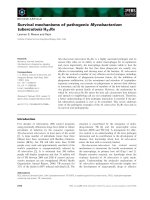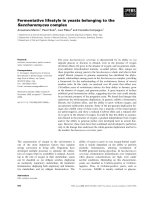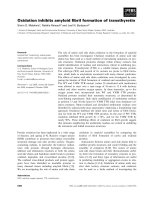Tài liệu Báo cáo khoa học: "Arabic Syntactic Trees: from Constituency to Dependency" ppt
Bạn đang xem bản rút gọn của tài liệu. Xem và tải ngay bản đầy đủ của tài liệu tại đây (234.12 KB, 4 trang )
Arabic Syntactic Trees: from Constituency to Dependency
Zdeneli ‘iabokrtskST
and
Otakar Smri
Center for Computational Linguistics
Faculty of Mathematics and Physics
Charles University in Prague
{zabokrtsky,smrz}@ckl.mff.cuni.cz
Abstract
This research note reports on the work
in progress which regards automatic
transformation of phrase-structure syn-
tactic trees of Arabic into dependency-
-driven analytical ones. Guidelines for
these descriptions have been developed
at the Linguistic Data Consortium, Uni-
versity of Pennsylvania, and at the Fac-
ulty of Mathematics and Physics and the
Faculty of Arts, Charles University in
Prague, respectively.
The transformation consists of (i) a re-
cursive function translating the topology
of a phrase tree into a corresponding de-
pendency tree, and (ii) a procedure as-
signing analytical functions to the nodes
of the dependency tree.
Apart from an outline of the annota-
tion schemes and a deeper insight into
these procedures, model application of
the transformation is given herein.
1 Introduction
Exploring the relationship between constituency
and dependency sentence representations is not a
new issue—the first studies go back to the 60's
(Gaifman (1965); for more references, see e.g.
Schneider (1998)). Still, some theoretical find-
ings had not been applicable until the first de-
pendency treebanks with well-defined annotation
schemes came into existence just in the very last
years (Haji6 et al., 2001).
The need to convert Arabic treebank data of
different descriptions arises from a co-operation
between the Linguistic Data Consortium (LDC),
University of Pennsylvania, and three concerned
institutions of Charles University in Prague,
namely the Center for Computational Linguistics,
the Institute of Formal and Applied Linguistics,
and the Institute of Comparative Linguistics.
The two parties intend to share the resources
they create. Prior to this exchange, 10,000 words
from the LDC Arabic Newswire A Corpus were
manually annotated in both syntactic styles as a
step to ensure that the annotations are re-usable
and their concepts mutually compatible. Here we
attempt the constituency–dependency direction of
the transfer.
1.1 Phrase-structure trees
The input data come from the LDC team
(Maamouri et al., 2003). The annotation scheme is
based on constituent-syntax bracketing style used
at the University of Pennsylvania (Maamouri and
Cieri, 2002). The trees include nodes for surface
text tokens as well as non-terminal nodes follow-
ing from the descriptive grammar. Not only syn-
tactic elements, but also several kinds of structural
reconstructions (traces) are captured here.
1.2 Analytical trees
Under the analytical tree structure we understand
a representation of the surface sentence in form of
a dependency tree. The node set consists of all the
tokens determined after morphological analysis of
the text, and the sentence root node. The descrip-
tion recovers the relation between a governor and
a node dependent on it. The nature of the govern-
ment is expressed by the analytical functions of
the nodes being linked
183
0
VERB
ya+kun
(it) was
*TRACE
NP-SBJ
0
PREP
min
from
0
NEG_PART
-lam
not
NP-P D
0
NOUN
muwAjah+ap
confrontation
NP
CONJ
ma-
and
0
CONJ
wa-
and
0
CONJ
wa-
and
0
PERIOD
0
0
PRON VERB
-huwa ya+SoEad
he
(he) gets on
*T"TRACE
NP-SBJ-1 NP-OBJ
0
DET+NOUN
Al+bAS
the bus
DET+NOUN PREP
Al+sahol
Ealay-
the easy
on
NP NOUN
kAmiyr+At
cameras j
)
NP
NOUN
NP
-Eadas+At
lenses j
)
PRON
DET+NOUN
DET+NOUN
-hi
Al+tilfizyuwn
Al+muSaw—ir+iyona
him
the television
the photographers
Figure 1: The model sentence in the phrase-structure syntactic description. The nodes are labeled either
with part-of-speech (POS) tags, or with the names of non-terminals.
1.3 Model sentence
Let us give a model sentence which in its phonetic
transcript and translation reads
Wa lam yakun mina 's-sahli calay
hi muwc7kahatu käinirCiti
wa cadasati 7-musawwirrna wa huwa
ya,scadu 1-bd,sa.
It was not easy for him to face the tele-
vision cameras and the lenses of photog-
raphers as he was getting on the bus.
Its respective representations in Figures 1 and 2
use glossed tokens which are further split into
morphemes and transliterated in Tim Buckwalter's
notation of graphemes of the Arabic script.
There are three phenomena to focus on in the
trees. Firstly, occurrence of the empty trace
(*TRACE) NP-SBJ
or the
(*T*TRACE) NP-SBJ-1
one with its contents moved to
NP-TPC-1.
Sec-
ondly, subtree interpretation may be sensitive to
other than the top-level nodes, like when the coor-
dination
S CONJ S
produces the subordinate com-
plement clause
Pred (Atv)
due to the idiomatic
context of the pronoun. Finally to note are com-
plex rearrangements of special constructs, as is the
case of
NP-SBJ PP NP-PRD
versus
AuxP AuxP Sb
nodes and their subtrees. More discussion follows.
1.4 Outline of the transformation
The two tree types in question differ in the topol-
ogy as well as in the attributes of the nodes. Thus,
the problem is decomposed into two parts:
i)
creation of the dependency tree topology, i.e.
contraction of the phrase-structure tree based
mostly on the concept of phrase heads and on
resolution of traces,
ii)
assignment of labels describing the analytical
function of the node within the target tree.
2 Structural Transformation
2.1 The core algorithm
The principle of the conversion of phrase struc-
tures into dependency structures is described
clearly in Xia and Palmer (2001) as (a) mark the
184
Sb
-huwa
he
Atv
ya+SoEad
(he) gets on
Obj
Al+bAS
the bus
Aux
Pied
ya+kun
(it) was
AuxM
AuxP
AuxP
Sb
-lam
min
Ealay-
muwAjah+ap
not from
on \
confrontation
AuxY
Pnom
Obj
Chord
wa-
Al+sahol
-hi
ma-
a nd
the easy
him
and
AuxK
Atr_Co
Atr_Co
AuxY
kAmiyr+At
-Eadas+At
ma-
cameras
lenses
and
Atr
Atr
Al+tilfizyuwn
Al+muSaw—ir+iyona
the television
the photographers
Figure 2: The model sentence in the dependency analytical description, showing the nodes and their
functions in the hierarchy.
head child of each node in a phrase structure, using
the head percolation table, and (b) in the depen-
dency structure, make the head of each non-head
child depend on the head of the head-child.
In our implementation, the topology of the an-
alytical tree is derived from the topology of the
phrase tree by a recursive function, which has the
following input arguments: original phrase tree
T
p
h
r
, dependency tree
T
dep
being created, one par-
ticular node
s
p
h,
from
T
p
h,
(the root of the phrase
subtree to be processed), and node
p
dep
from
T
dep
(the future parent of the subtree being processed).
The function returns the root of the created analyt-
ical subtree. The recursion works like this:
1.
If
s
p
h,
is a terminal node, then create a sin-
gle analytical node nd
ep
in
Td
ep
and attach it
below
pd
ep
;
return nd
ep
;
2.
Otherwise (s
p
h, is a nonterminal), choose
the head node
h
p
h,
among the children of
Sphr,
recursively call the function with h
p
h,
as the phrase subtree root argument, and store
its return value r
dep
(root of the recursively
created dependency subtree); recursively call
the function for each remaining
s
phr
's
child
nphr,i,
and attach the returned subtree root
Odep,i
below rd
ep
; return rd
ep
.
2.2 Appointing heads
Rules for the selection of phrase heads follow
from the analytical annotation guidelines. Pred-
icates are considered the uppermost nodes of a
clause, prepositions govern the rest of a prepo-
sitional phrase, auxiliary words are annotated as
leaves etc. Non-verbal predication, so frequent in
Arabic syntax, is also formalized into the terms of
dependency, cf. Smrsi et al. (2002).
With the algorithm taking decisions about the
head child before scanning the subtrees of the
level, the already mentioned clause
huwa yascadu
Thasa
qualifies improperly as a sister to the predi-
cate
yakun
of the main clause. In fact, we are deal-
ing with the so called state or complement clause.
Therefore, corrective shuffling in this respect is in-
evitable.
2.3 Tree post-processing
Completion of the dependency tree also involves
pruning of subtrees which are co-indexed with
some trace, and attaching them in place of the re-
ferring trace node. Typically, this is the case for
clauses having an explicit subject before the pred-
icate. In the model sentence,
yascadu
retains its
role as a predicate of the clause, no matter what
function it receives from its governor.
185
3 Analytical Function Assignment
The analytical function can be deduced well from
the POS of the node and the sequence of labels of
all its ancestors in the phrase tree, and from the
POS or the lexical attributes of its parent in the
dependency tree. That is why this step succeeds
the structural changes.
Problems may appear though if the declared
constituents are not consistent enough, relative to
the analytical concept. While
NP-SBJ, PP
and
NP-
Po
would normally imply
Sb, AuxP
and
Pnom,
these get in principal conflict in the type of nom-
inal predicates like
mina 's
-
sahli
followed by an
optional object and a rhematic subject. The Fig-
ures provide the best insight into the differences.
4 Evaluation and Conclusion
Preliminary evaluation gives 60 % accuracy of the
generated tree topology, and roughly the same
rate for analytical function assignment. The mea-
sure is the percentage of correct values of par-
ents/functions among all values. The work is in
progress, however. According to our experience
with similar task for Czech, English (2abokrts14
and Kuèerova, 2002) and German, we expect the
performance to improve up to 90 % and 85 % as
more phenomena are treated.
The experience made during this task shall be
useful for the development of a rule-based de-
pendency partial analysis, which shall pre-process
data for manual analytical annotation.
Acknowledgements
Development and fine-tuning of the transforma-
tion procedures would not have been possible
without the TrEd tree editor by Petr Paj as of the
Charles University in Prague. The Figures were
produced with it, too.
The phonetic transcription of Arabic within this
paper was typeset using the ArabTEX package for
TEX and IMEX by Prof. Dr. Klaus Lagally of the
University of Stuttgart.
The research described herein has been support-
ed by the Ministry of Education of the Czech Re-
public, projects LNO0A063 and MSM113200006.
References
Haim Gaifman. 1965. Dependency Systems and
Phrase-Structure Systems.
Information and Control,
pages 304-337.
Jan Haile, Eva Hajieova, Petr Pajas, Jarmila Panevova,
Petr Sgall, and Barbora Vidova-Hladka. 2001.
Prague Dependency Treebank 1.0 (Final Produc-
tion Label). CDROM CAT: LDC2001T10, ISBN
1-58563-212-0.
Mohamed Maamouri and Christopher Cieri. 2002.
Resources for Natural Language Processing at the
Linguistic Data Consortium. In
Proceedings of the
International Symposium on Processing of Arabic,
pages 125-146, Tunisia, April 18th-20th. Faculte
des Lettres, University of Manouba.
Mohamed Maamouri, Ann Bies, Hubert Jin, and Tim
Buckwalter. 2003. Arabic Treebank: Part 1 v 2.0.
LDC catalog number LDC2003T06, ISBN 1-58563-
261-9.
Gerold Schneider. 1998. A Linguistic Compari-
son Constituency, Dependency, and Link Grammar.
Master's thesis, University of Zurich.
Otakar Smil, Jan 'litaidauf, and Petr Zemanek. 2002.
Prague Dependency Treebank for Arabic: Multi-
Level Annotation of Arabic Corpus. In
Proceed-
ings of the International Symposium on Processing
of Arabic,
pages 147-155, Tunisia, April 18th-20th.
Faculte des Lettres, University of Manouba.
Fei Xia and Martha Palmer. 2001. Converting De-
pendency Structures to Phrase Structures. In
Pro-
ceedings of the Human Language Technology Con-
ference (HLT-2001),
San Diego, CA, March 18-21.
Zdetlek abokrtsk3 and Ivona Kue'erova. 2002. Trans-
forming Penn Treebank Phrase Trees into (Praguian)
Tectogrammatical Dependency Trees. Prague Bul-
letin of Mathematical Linguistics,
(78):77-94.
186









